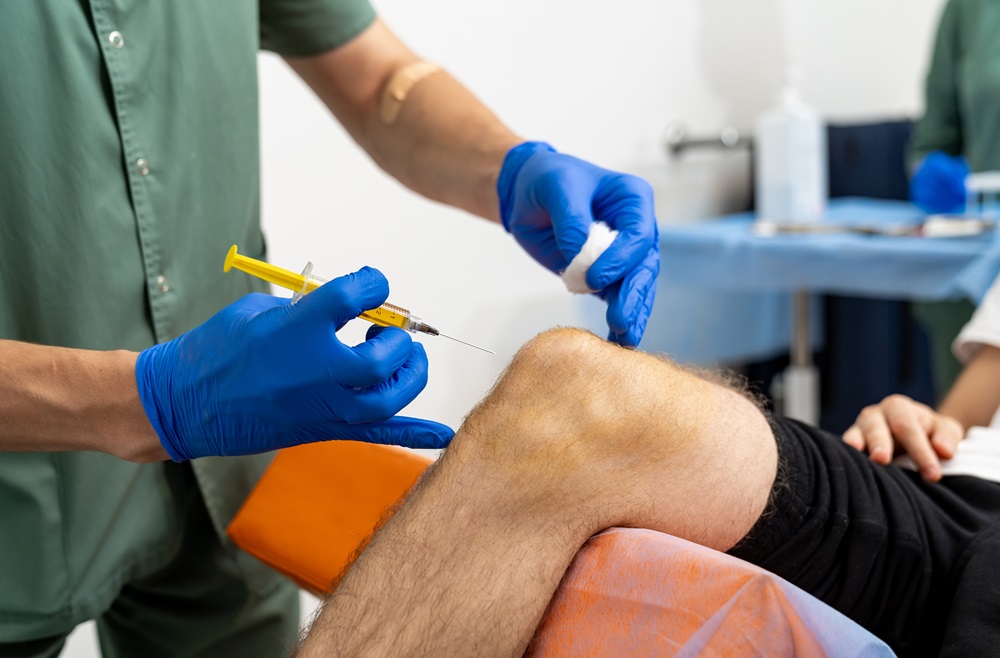If you’re dealing with bone-on-bone knee arthritis, you’ve probably heard about stem cell injections for arthritis as a potential solution.
When your knee pain is constant and walking feels impossible, any treatment that promises relief sounds appealing. But what actually happens when you inject stem cells into severely damaged knees?
The Reality of Grade IV Knee Arthritis
Grade IV arthritis means your knee cartilage is essentially gone. You’re dealing with what doctors call “bone-on-bone” contact. This is the most severe form of knee arthritis on the Kellgren-Lawrence scale.
Your knee joint looks completely different now. Where smooth cartilage once cushioned your bones, you have rough surfaces grinding against each other. Bone spurs have likely formed, and your joint space has narrowed significantly or disappeared entirely.
The pain you feel isn’t just discomfort – it’s your bones literally rubbing together with every step.
How Stem Cell Injections Work in Damaged Knees
Stem cells are your body’s repair cells. They can potentially transform into different types of tissue, including cartilage. When doctors inject these cells into your knee, the goal is cartilage regeneration.
The process involves extracting stem cells from your bone marrow or fat tissue, concentrating them, and injecting them directly into your knee joint. Some clinics also add platelet-rich plasma (PRP) to enhance the healing response.
But here’s what you need to know: severely damaged joints present unique challenges. Your Grade IV arthritis means there’s limited healthy tissue for stem cells to work with.
Success Rates and Clinical Evidence
The research on stem cell therapy for severe arthritis shows mixed results. Studies indicate that patients with early-stage arthritis (Grades I-II) see better outcomes than those with advanced disease.
| Arthritis Grade | Success Rate | Pain Reduction |
| Grade I-II | 60-70% | Moderate to significant |
| Grade III-IV | 30-45% | Mild to moderate |
A 2019 study in the Journal of Clinical Medicine followed 91 patients with Grade IV arthritis for two years. Only 37% experienced meaningful improvement, and most still needed additional treatments.
What You Can Realistically Expect
If you’re considering stem cell therapy for bone-on-bone arthritis, set realistic expectations:
Potential Benefits:
- Reduced inflammation and pain
- Improved joint function
- Delayed need for knee replacement
- Better quality of life
Limitations:
- Cannot regenerate significant amounts of cartilage in severely damaged joints
- Results vary greatly between patients
- Multiple treatments often needed
- Not a cure for advanced arthritis
Most patients with Grade IV arthritis who see improvement report moderate pain reduction rather than complete relief. You might find walking easier and need fewer pain medications, but your knee won’t return to normal function.
The Treatment Process
Getting stem cell injections isn’t a one-time fix. The typical process involves:
Your doctor will first extract stem cells through a minor procedure. This usually takes 1-2 hours and involves either bone marrow aspiration from your hip or fat extraction through liposuction.
The cells are then processed and concentrated in a lab, which can take several hours. Finally, your doctor injects the stem cells directly into your knee joint using ultrasound guidance.
Recovery time is generally shorter than surgery – most patients return to normal activities within a few days. However, you might need 2-4 injections spaced several months apart for optimal results.
Comparing Your Options
| Treatment | Pain Relief | Recovery Time | Durability |
| Stem Cell Therapy | Moderate | 1-2 weeks | 1-2 years |
| Knee Replacement | Significant | 3-6 months | 15-20 years |
| Conservative Care | Mild | Ongoing | Variable |
For Grade IV arthritis, knee replacement surgery remains the gold standard treatment. It provides more predictable and longer-lasting results than stem cell therapy.
Who Might Benefit Most
Stem cell injections work best for patients who:
- Want to delay knee replacement surgery
- Have failed conservative treatments
- Are too young or unhealthy for major surgery
- Have some remaining cartilage (though minimal in Grade IV)
You’re less likely to see significant improvement if you have complete cartilage loss, severe bone deformity, or unrealistic expectations about returning to high-impact activities.
Cost and Insurance Considerations
Most insurance plans don’t cover stem cell therapy for arthritis since it’s considered experimental. You’ll likely pay $3,000-$8,000 out of pocket per treatment.
Compare this to knee replacement surgery, which insurance typically covers and costs $30,000-$50,000 total (though your out-of-pocket costs are much lower with insurance).

Making the Right Decision
Stem cell therapy isn’t a miracle cure for bone-on-bone arthritis, but it might help some patients manage symptoms and delay surgery. The key is having realistic expectations about what these injections can and cannot do.
Talk with your orthopedic surgeon about whether you’re a good candidate. Consider factors like your age, activity level, pain tolerance, and financial situation.
Remember that while stem cell injections for arthritis show promise, knee replacement surgery remains the most effective treatment for severe, bone-on-bone arthritis when conservative care fails.
Frequently Asked Questions
Can stem cell injections regrow cartilage in bone-on-bone knees?
Answer: Not completely. In Grade IV arthritis (bone-on-bone), stem cells can help reduce inflammation and pain, but they can’t fully regenerate lost cartilage. They may, however, improve joint function and delay the need for knee replacement.
How successful are stem cell injections for severe knee arthritis?
Answer: Research shows mixed results. Patients with early-stage arthritis (Grades I–II) see about 60–70% success, while those with severe Grade IV arthritis typically experience 30–45% improvement—mainly pain reduction, not full cartilage regrowth.
How long do stem cell injection results last for knee arthritis?
Answer: Results can last 1–2 years for many patients, depending on arthritis severity and overall health. Multiple treatments spaced several months apart may be needed to maintain benefits.
Is stem cell therapy better than knee replacement for bone-on-bone arthritis?
Answer: For severe, bone-on-bone cases, knee replacement remains the gold standard. Stem cell therapy may help delay surgery and provide moderate relief, but it doesn’t restore full joint function like replacement surgery can.
How much do stem cell injections for arthritis cost?
Answer: Stem cell therapy typically costs $3,000–$8,000 per treatment and isn’t covered by most insurance. In comparison, knee replacement surgery costs much more overall but is usually covered by insurance.

